BY LETTER
Mass-Stream Technology (Space Fountains and Orbital Rings)
Technology > Technology Type or Material > Drytech/Hylotech
Technology > Technology Levels > High Tech / Hitech
Technology > Application > Infrastructure
Technology > Application > Megascale Engineering
Technology > Technology Levels > High Tech / Hitech
Technology > Application > Infrastructure
Technology > Application > Megascale Engineering
Technologies used to support large scale structures using momentum | |
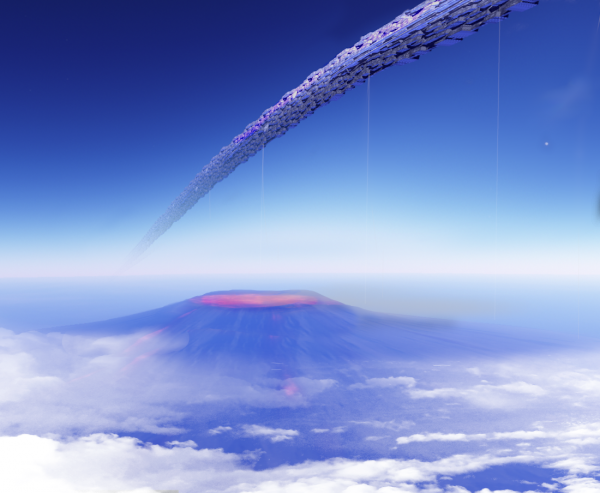 Image from Steve Bowers | |
| An orbital ring, suspended 100km above the world Wegener | |
Using accelerated streams of projectiles or particles to either transfer momentum or support a large structure.
The transfer of momentum by the use of massive particles is a technique which is widely used in the Terragen Sphere, both in the Beamrider Network and boosteam launch systems, and also in the construction of large, dynamically supported megastructures. Despite the apparent vulnerability of such systems to possible power failures, they are actually quite safe and reliable.
Applications include:
- Construction of supra-planetary habitat shells around gas giants or even stars at a level where the underbody generates gravity equal to whatever is desired by the builders.
- Building an orbital ring around a planet and using it to support short (approx. 400-800km) skyhooks to provide ground to orbit travel.
- Setting up a network of mass streams to provide rapid transit for vehicles around a solar system. The vehicles magnetically couple to the stream and "ride" it.
- At its upper limits the technology can move a planet or even a star in a time span of decades.
Mass-stream technology is widely employed in the MPA. Often the sheer engineering beauty of a Lofstrom Loop or Space Fountain in their aesthetic encourages them to build it.
Mass Stream Technology - Examples
Space Fountains - A space fountain consists of a looped stream of massive particles constrained in magnetic fields, supporting a tall structure.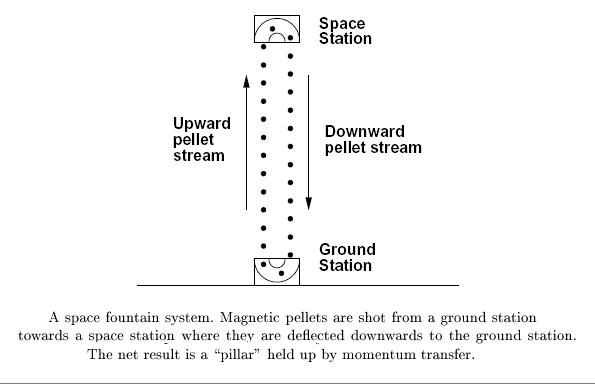 Image from Anders Sandberg |
A space fountain incorporates a continuous mass driver which propels captive particles with significant mass inside a closed loop. These particles must consist of, or be coated with, a material which is strongly affected by magnetic fields. The particles are projected upward from the bottom of the tower, and on the way up are controlled and partially braked by electromagnetic devices, which generate both electricity and a certain amount of lift. The particles are redirected back down by a large bending magnet once they reach the top, and the force of redirection holds the top of the tower up. The particle beams must be contained within evacuated tubes to avoid friction, especially in the lower parts of a planetary atmosphere. Often the space fountain is used for access to space, however the top of the tower is not travelling at orbital speed so some other method of acceleration, such as tether technology, reaction drives or mass drivers must be used to place payloads in orbit.
Space fountains can be used to support planetary structures larger than any which can be built with conventional matter materials in compression or tension; while truly large structures such as orbital rings and supramundane worlds can be built above the surface of any object with gravity.
Dynamic Compression Members - Using space fountain technology, very strong supporting 'beams' can be constructed to support megastructure elements that would collapse if they were dependent on structural strength alone.
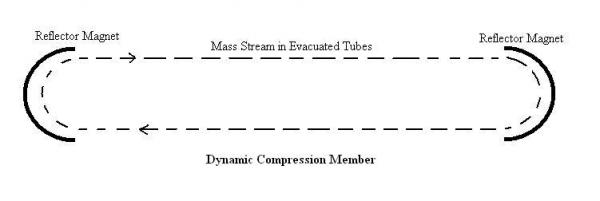 Image from Steve Bowers |
Space fountain technology can be used inside structures as so-called dynamic compression members to add extra strength, allowing construction to reach heights impossible with non-dynamic methods. Giant buildings reaching far into space are sometimes built on planetary surfaces using fountains as internal support. Dynamic Compression Members can be used in space to support large structures against their own gravity, and to strengthen light sails and magnetic sail systems. Large beamrider ships often have sails strengthened by a number of mass streams.
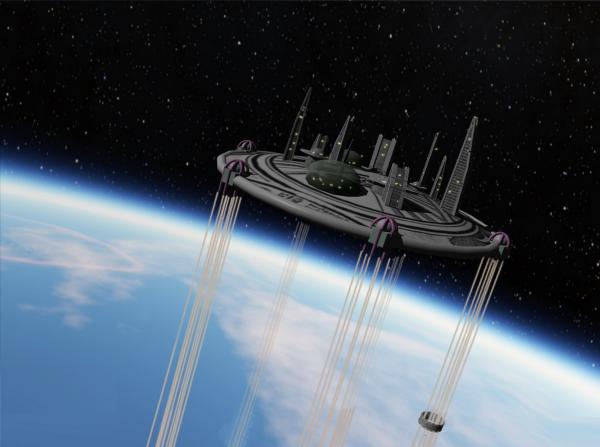 Image from Steve Bowers | |
| New Phoenix City, suspended on eighteen space fountains above Florizel | |
Dynamic Orbital Rings - Often called Orbital Rings; dynamic orbital rings are a more advanced application of mass-beam momentum transfer technology, first proposed in the Information Age by Paul Birch. A continuous stream of magnetic particles are placed in orbit around a planet, and encased in a tube lined with electromagnetic devices which accelerate the mass of the stream until it is moving faster than orbital speed. The stream will exert a net force outwards as it attempts to move into a higher orbit, but it is constrained by the tube and the electromagnetic control systems, which redirect the mass-stream back towards the planet, creating a net outwards force in the ring which can be used to support a payload.
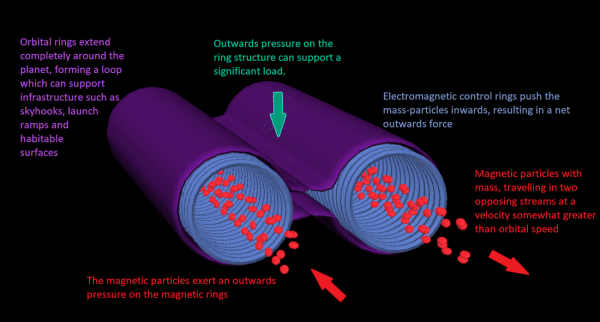 Image from Steve Bowers | |
| Orbital rings sometimes use streams of separate particles (as shown here), or a continuous, segmented ferromagnetic core (known as a rotor) | |
In practice a typical, circular orbital ring around a terrestrial world consists of a continuous ring of dense material, often a silicate (glass-fibre) hoop or cable, which is coated on the outside with a ferromagnetic or paramagnetic material. However, larger rings, elliptical or otherwise irregular rings use mass-streams made up of individual mass particles, an arrangement which is more flexible.
 Image from Steve Bowers | |
| Venus is surrounded by a Dynamic Orbital Ring | |
The orbital ring need not be located around the equator; sideways acceleration can control precession so that the ring can have any inclination. If several rings are superimposed, gradually a sphere can be constructed in the so called 'ball of string' configuration; more rings in a gridlike-x-y-z configuration can be added on top eventually forming a supramundane structure or a suprastellar structure above a star. (see Supermundane Worlds and Artificial Planets)
Some orbital rings support biological frameworks, such as the Noovelean tree, a space-tolerant plant that surrounds its planet, trailing vine-like elevators to the ground. The provolved arachnids of genus Hobo Sapiens and Aranea cosmoi are famous for their web-like elevators that stretch from orbital rings to the ground, supporting spider colonies and habitats for other species.
Mass stream technology may also be used for transport (vehicles can be coupled to a mass stream and accelerated in the same way as the streams are, but on the outside of the stream) and cooling (objects can transfer heat to mass streams which then radiate the energy to space in a remote location). Both applications are extensively used in the Xi Scorpii system among the
Kiyoshi dyson shells.
Suprashells and Artificial Planets - Suprashells normally surround planets or stars, while artificial planets generally enclose small black holes created for the purpose.
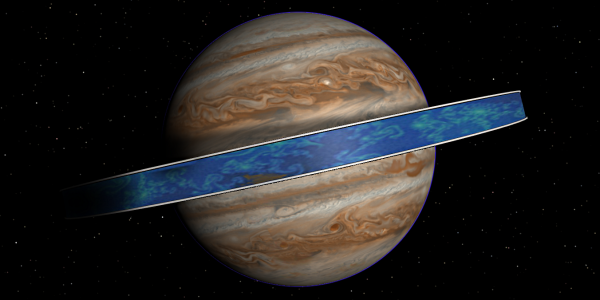 Image from Steve Bowers | |
| A suprajovian ring suspended above the gas giant Mungo | |
These structures consist of arrays of orbital rings, covered by load-bearing landscape surfaces.
Image from Steve Bowers | |
| Supra-black-hole worlds are constructed on a dynamically supported framework above an artificially produced, planetary mass black hole. The size of the planet is optional, as is the surface gravity; the worlds can be much smaller, or much larger, than planets with similar surface conditions. | |
Lofstrom Loops - Dynamic launch system using a continuous stream of linked magnetic units to raise payloads above the atmosphere and launch them into orbit.
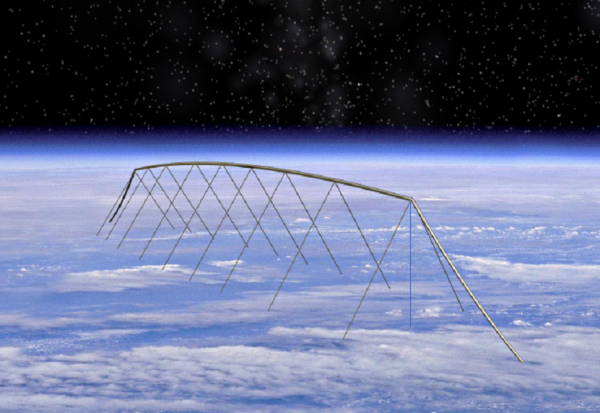 Image from Steve Bowers | |
| This Lofstrom Loop was the first ever raised above the Earth, at the start of the Great Expulsion | |
Lofstrom Loops - named after Keith Lofstrom, who set forth the first detailed calculations on the Launch Loop concept during the late Atomic/early Information period - magnetically accelerate a linked chain of metallic ribbon-like units to such high speed that the ribbon is lifted off the ground and must be held down by stabilizing cables. The stream is held at the edge of space, typically about 80km up. At the top the loop runs horizontally for 2000km, allowing payloads to be accelerated along it to orbital speed. The continuous stream of metal links then descends to the ground, where it is reversed by a large, loop shaped accelerator. The stream is then sent back aloft and repeats its journey to the original ground station.
Vertical elevators raise payloads to the westernmost end, to start their acceleration to orbital speed; the loop is only used for launches, as aerobraking is generally used for descending traffic on worlds wherever Lofstrom Loops are used.
The loop structure contains a large amount of kinetic energy but, because it is only raised gradually, only requires enough energy to compensate for losses when finished.
The first Loop was built by GAIA during the Great Expulsion, the first of many constructed at that time to assist in the mammoth task of evacuating Earth. Many medium tech worlds use launch loops whenever full-scale space elevators are not available. Another system used in similar circumstances is the Rotovator.
Partial Orbital Ring Systems - Similar to the Lofstrom Loop, PORS consist of only a part of an orbital ring with deflector magnets at each end.
 Image from Steve Bowers |
Bridges have been constructed on a number of worlds reaching far across an ocean from one continent to another; PORS systems are also convenient for ground to orbit access if they are used to support a payload acceleration system above the atmosphere.
 Image from Steve Bowers | |
| The Great Canyon Bridge over the Valles Marineris Sea is supported by mass-stream technology | |
Related Articles
- Artificial Planets
- Beamed Energy Propulsion
- Fractaroni Spaghetti Worms
- Lofstrom Loop
- Lorrey Loop - Text by Steve Bowers
Advanced form of Lofstrom Loop using three geostationary terminii in orbit at the points of an equilateral triangle, and three ground terminii opposite them, connected by a stream of vessels or particles which travel in Hofmann orbits (except when in the atmosphere), thereby saving energy. - Noovleann Tree
- Rotovator
- Space Cities
- Space Runways
- Supramundane and Suprastellar Worlds
- Vertical Skyhooks and Static Orbital Rings
Appears in Topics
Development Notes
Text by Todd Drashner; Steve Bowers;
additional notes by Anders Sandberg
Initially published on 12 December 2001.
additional notes by Anders Sandberg
Initially published on 12 December 2001.
Additional Information
The Paul Birch Archive at Orion's Arm






